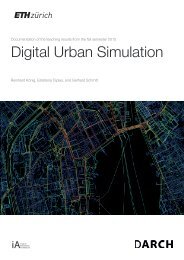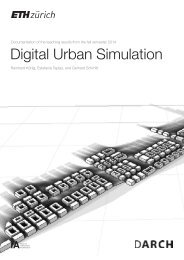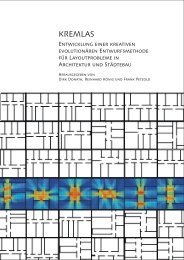New methods in urban analysis and simulation
Documentation of teaching results from the spring semester 2015 of the seminar Digital Urban Simulation at the Chair of Information Architecture, ETH Zurich
Documentation of teaching results from the spring semester 2015 of the seminar Digital Urban Simulation at the Chair of Information Architecture, ETH Zurich
You also want an ePaper? Increase the reach of your titles
YUMPU automatically turns print PDFs into web optimized ePapers that Google loves.
5<br />
< axial design option 2 ><br />
The option two constitutes of a more hut structure<br />
where the gardens <strong>and</strong> the public amenities<br />
co-exist <strong>and</strong> the circulation path that is created<br />
would become the “public” space for the pedestrian<br />
traffic.<br />
I analysed the space at a radius of 3 <strong>and</strong> the<br />
results show that the public space <strong>in</strong> the design<br />
seems to be less <strong>in</strong>tegrated but not so well connected<br />
with its surround<strong>in</strong>gs. The reason maybe<br />
because of the appearance of angular changes<br />
when navigat<strong>in</strong>g through the space. It requires<br />
more changes <strong>in</strong> angle, from cross<strong>in</strong>g from one<br />
street to the other than would option one, thus<br />
giv<strong>in</strong>g less connectivity <strong>and</strong> <strong>in</strong>tegration values.<br />
<strong>New</strong> Methods <strong>in</strong> Urban Analysis <strong>and</strong> Simulation I<br />
38








